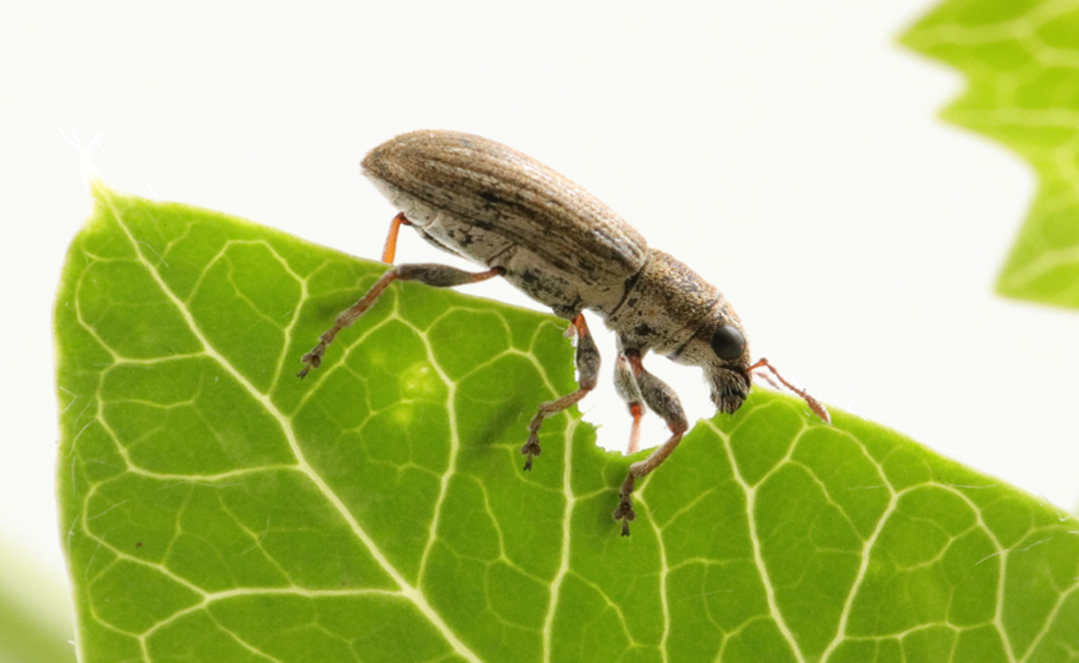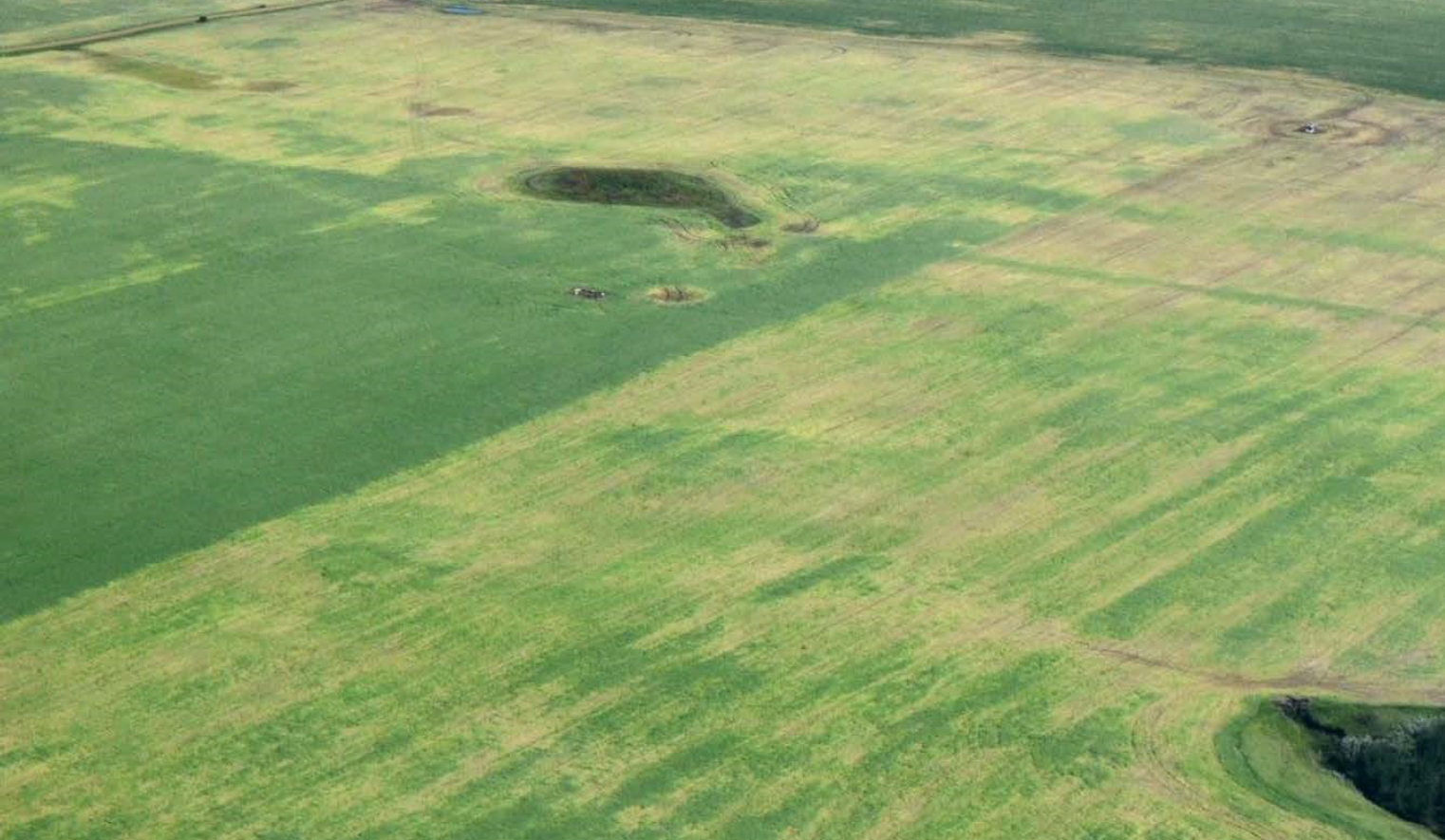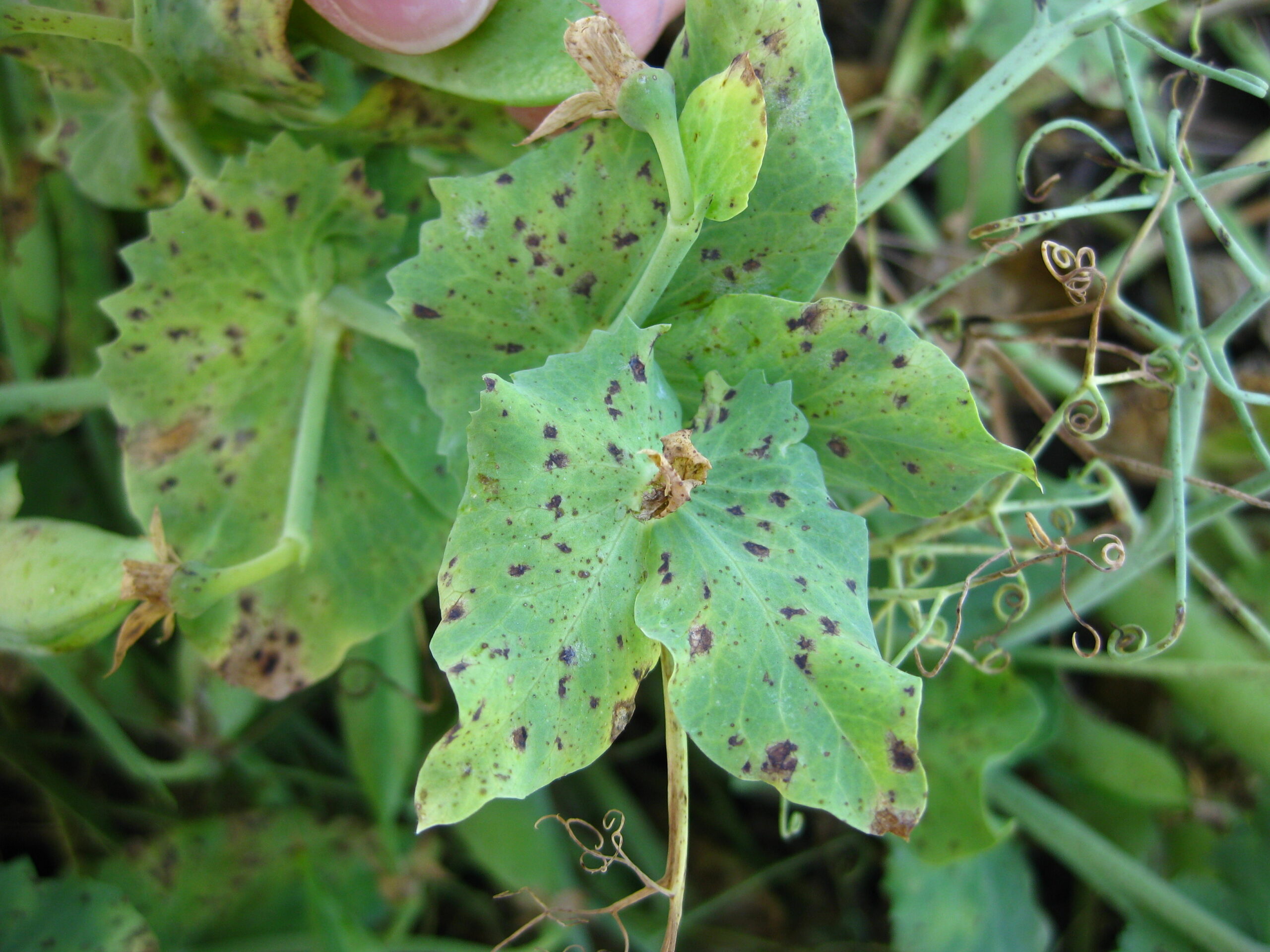Jennifer Bogdan, P.Ag., CCA
Pea leaf weevil (Sitona lineatus) is an emerging pest in pulses that has been spreading north and east in Saskatchewan since it was first identified in the southwest in 2007. Of greatest concern are pea and faba bean crops, where larvae have the potential to cause economic damage by feeding on the nodules of these plants.
Host Crops and Feeding Damage
Peas and faba beans are the reproductive host plants for larval development and are therefore considered to be the primary hosts for pea leaf weevil. Secondary hosts that adult weevils will feed on include most other legumes (tame or wild) such as alfalfa, clover, sweet clover, vetch, lupins, black medick, dry beans, chickpeas, and soybeans. One study reported chickpeas becoming an alternate primary host when the pre ferred host (in this case, peas) was harvested as green manure. The resident weevils migrated to the chickpeas to mate and lay eggs. Lentils are neither a preferred feeding host for adults, nor a reproductive host for larvae.
Host plant preferences have been observed in lab studies and in the field. There is anecdotal evidence that adult pea leaf weevils prefer faba beans over peas during egg-laying if both host plants are available beside each other. This could be due to the longer maturity of faba beans providing habitat later into the season. There is also speculation that weevils feeding on faba beans may live longer than weevils feeding on peas, however this idea needs more understanding, and research is currently underway in Alberta to examine more about the relationship be tween host plants and pea leaf weevil.
Adult weevils feed on the leaf margins and growing points of host plants, creating characteristic notches in the foliage (Figures 1 and 2). While the damage may look alarming, the plants can generally compensate for the defoliation and the damage is mostly considered non-economical. Of exception are fields of seedling alfalfa, which can be prone to severe defoliation under high pea leaf weevil pressure, as reported in Alberta.
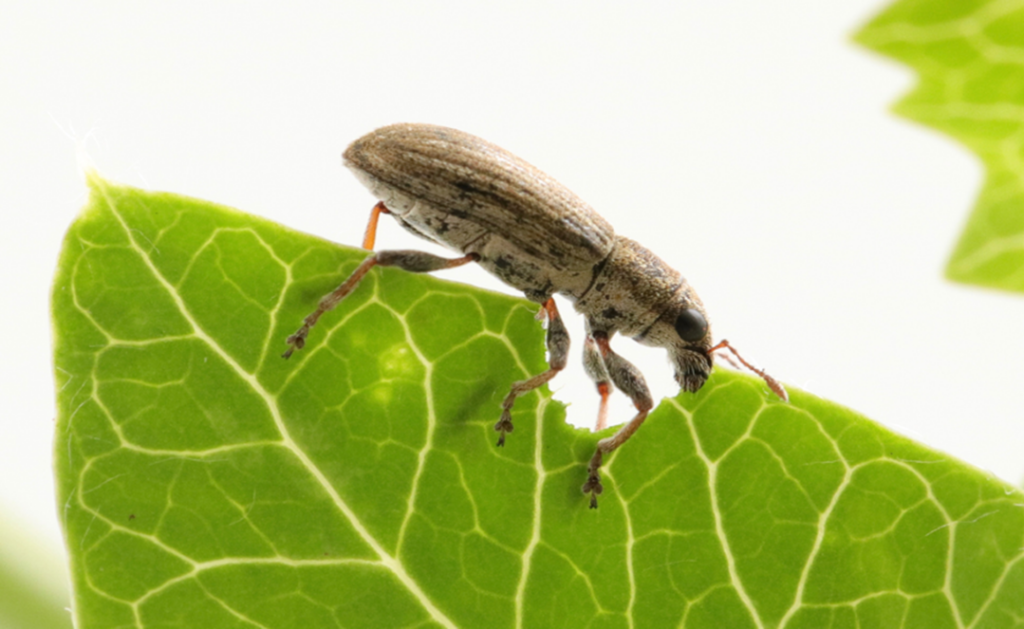
Source· Jonathon Williams, Agriculture and Agri-Food Canada
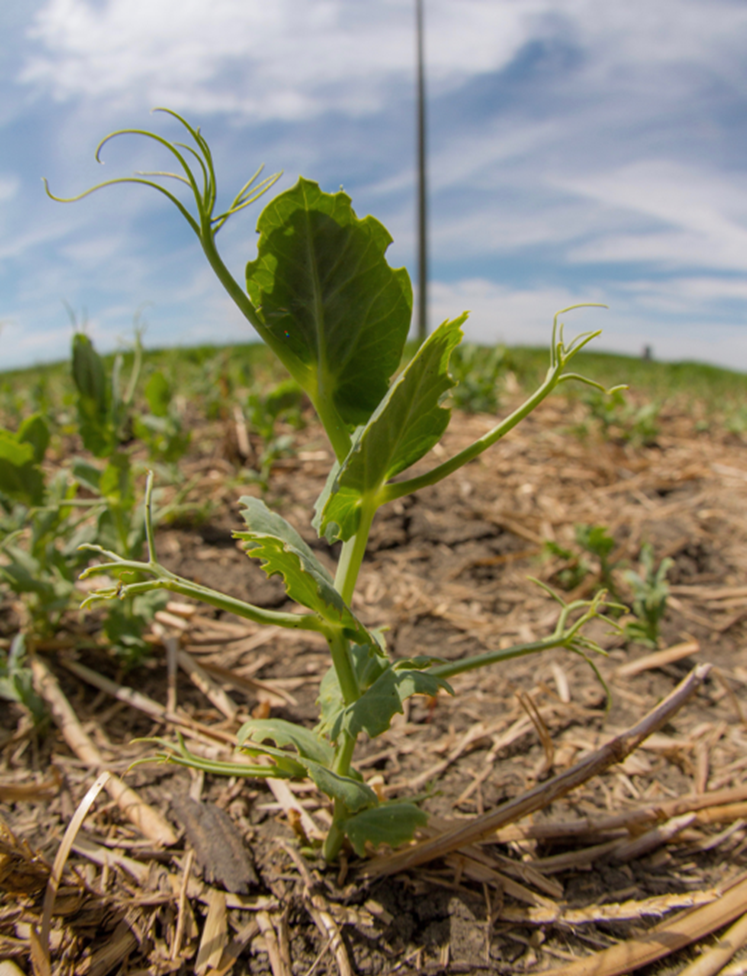
Source: Shelley Barkley
The most critical damage in peas and faba beans comes from the larvae feeding within the root nodules, thereby reducing nitrogen fixation by the crop. In turn, plant growth is poor, seed yield is reduced, and root damage can make the plants more susceptible to disease through secondary infection. Research plots in Lethbridge have seen over 90 per cent of the nodules damaged under high weevil density. Damage to the nodules peaks during flowering, when both nodulation and larval populations are at their highest
Differences in carrying capacity (the amount of larvae that a host plant can support) have been documented in peas and faba beans. Peas have a very low carrying capacity for pea leaf weevil larvae. Cage studies in Lethbridge have shown that the larval damage to the nodules under low weevil density (0 25 weevils per plant) was the same as the nodule damage under high weevil density (one weevil per plant). In other words, regardless of the number of adults present or eggs laid, the same economic damage can occur. It has been observed in the lab that faba beans can support more larvae than peas and therefore contribute to a faster population growth. However, more research is being conducted to validate this theory.
Identification
Adult: Slender, greyish-brown with short, wide snout Approximately five millimetres (mm) long with three light-coloured stripes on the thorax that extend lengthwise down the wing covers (elytra). These alternating light and dark stripes distinguish pea leaf weevil from other similar look ing Sitona species, such as the sweet clover weevil (Figure 3). Also, since older weevils may have worn off their scales that form the distinctive stripes, identification should be confirmed under a microscope by an experienced entomologist.
Sitona species occurring on the Canadian Prairies
|
Sitona ineatus Linnaeus: Pea leaf weevil |
Sitona cylindricollis Fahraeus: Sweet clover weevil |
Sitona lineelus Bonsdorff: Alfalfa curculio |
Sitona hispidula Fabricius: Clover root curculio |
|---|---|---|---|
|
5 mm long Three dorsal stripes extending laterally from head to abdomen. Unlike any other Sitona species, the fore-coxal cavities touch or nearly touch a narrow groove located on the ventral surface of the pronofum. Hosts: Peas, faba beans, seedling |
5 mm long Uniformly dark grey to black. Hosts: Sweet clover, seedling alfalfa, cicer milkvetch |
3 to 4 mm long Smaller and lighter in colour than S. cylindricollis Hosts: Alfalfa, sainfoin, cicer milkvetch, native vetches |
4 to 5 mm long Three dorsal stripes extending laterally from head to thorax. Spotting pattern on elytra. Hairy on abdomen. Hosts: Clovers, alfalfa, other legumes |

Source: Jennifer Otani, Agriculture and Agri-Food Canada
Egg: Yellow-white when laid, turns black prior to hatching (Figure 4)
Larva: Milky-white body with dark brown head capsule, measuring 3.5 to 5.5 mm long during final instar stage. Curls into a (-shape when disturbed (Figure 5)
Pupa: Milky-white, immobile, resting stage (Figure 6).
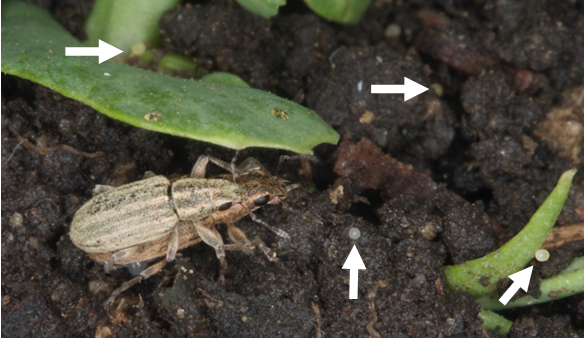
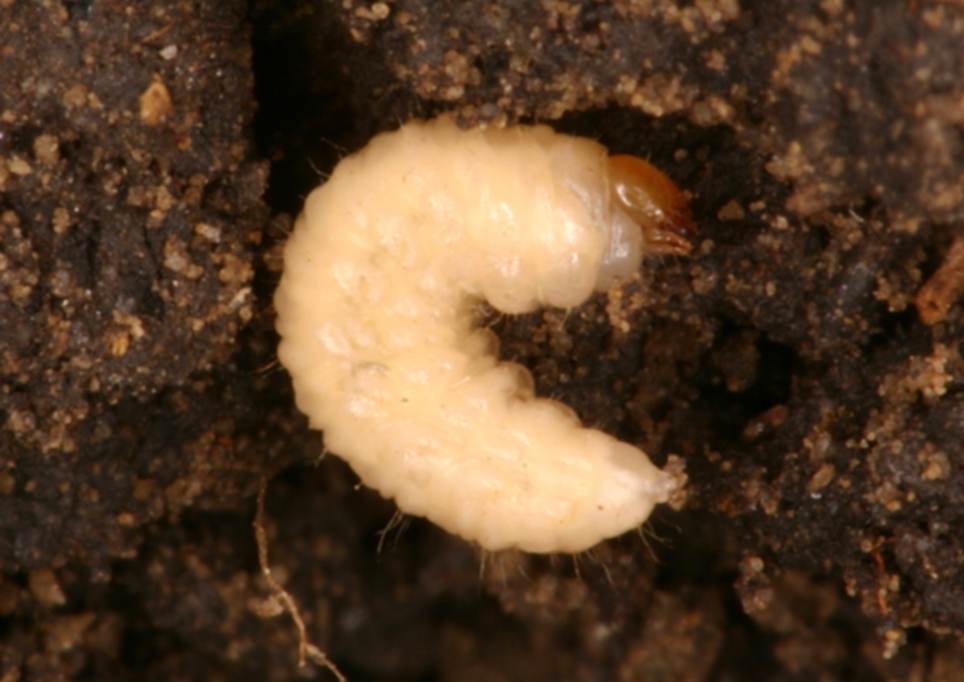
Source: Michael Dolinski
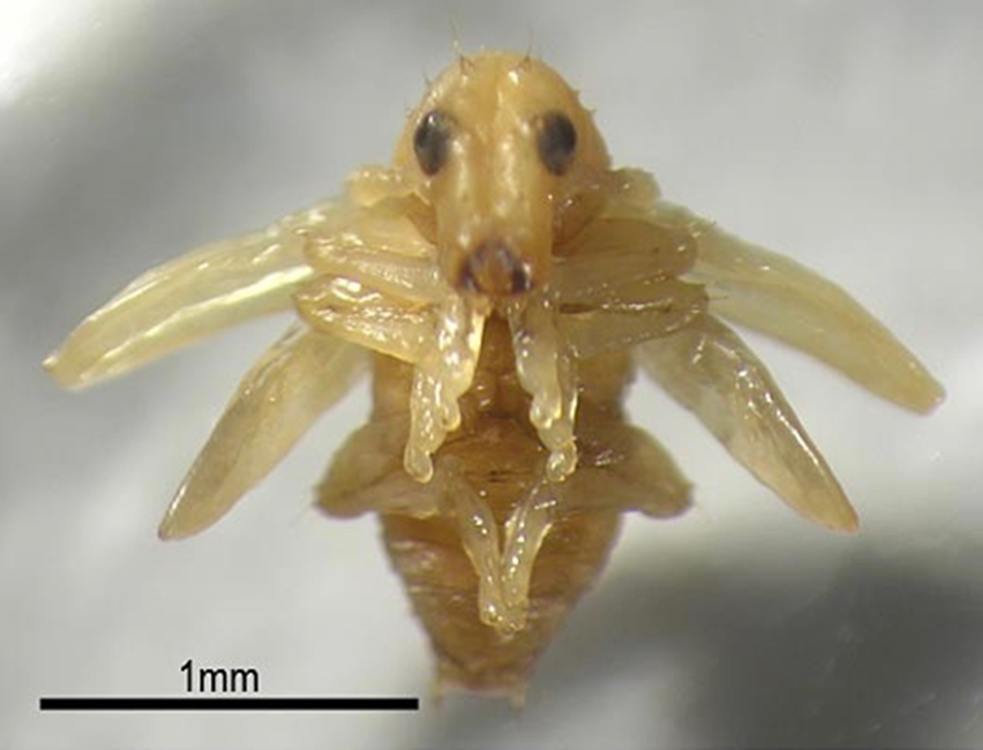
Source· Meghan Vankosky, University of Alberta
Life Cycle
The life cycle of the pea leaf weevil takes approximately nine to 11 weeks for completion. Only one generation per year is produced under Saskatchewan conditions.
Adult weevils overwinter in perennial legume fields, such as alfalfa, as well as in leaf litter habitats (shelterbelts and ditches) near these legume crops. Starting in late April or early May, adults emerge and begin feeding on any early-growing legume species, such as alfalfa, clover, and vetch. When temperatures are over 12°(, weevils take flight in search of pea or faba bean fields. Once a host field is found, further movement into the field is achieved by walking due to the flight muscles breaking down in order for reproductive material to be produced. Adults feed, mate, and then egg-laying begins within a week.
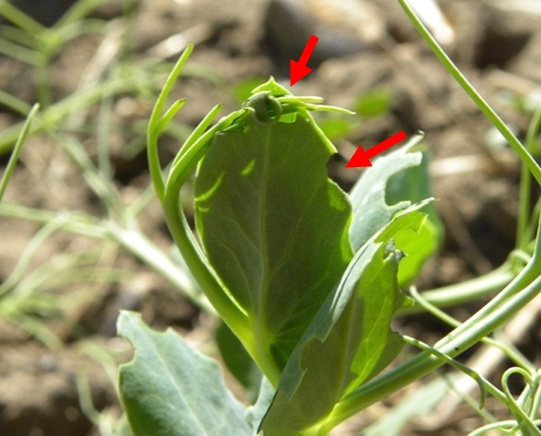
Source· Meghan Vankosky, Agriculture and Agri-Food Canada
Eggs are scattered on the soil surface near host plants as females for age for food. Female pea leaf weevils are very fertile-it is estimated that, on average, a single female will lay at least 1,000 to 1,500 eggs in her lifetime under field conditions. Egg-laying occurs throughout the summer, though most eggs are deposited primarily in May and June, with peak egg-laying occurring two to three weeks after arrival into the field. Eggs hatch in 18 to 20 days, depending on temperature and humidity.
Pea leaf weevil larvae pass through five instars in their life cycle, with the total larval stage requiring 30-60 days for completion. After hatching, first instar larvae crawl down through the soil in search of root nodules on pea and faba bean plants to burrow into. Larvae feed specifically on the nitrogen-fixing Rhizobia leguminosarum bacteria within the nodules throughout all instar stages. By early July, mature larvae can be found on roots. These larvae form an earthen cell in the soil in which to pupate in. Pupation lasts for 15 to 20 days.
New generation adults emerge by late July to early August, feeding on remaining green tissue of their host plants. Once plants start to senescence, pea leaf weevils will fly or walk to greener annual or perennial legumes to feed before overwintering in late fall. Feeding damage to these secondary host plants at this time is unlikely to be a concern, due to larger amounts of leaf material present. New generation adults are reproductively immature and remain in that state until they begin to feed on pea or faba bean foliage the following spring.
Scouting
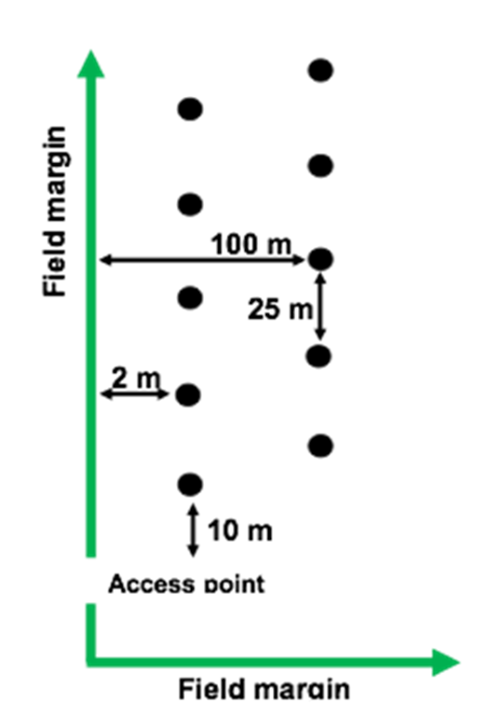
Source: Adapted from Pea leaf Weevil Monitoring Protocol, MA. Vankosky
Adult pea leaf weevils are difficult to scout for because they fall to the ground and ‘play dead’ when approached. Their brown colour makes them hard to see against the soil. Monitoring for pea leaf weevil involves assessing feeding damage in order to estimate the population density, rather than counting the adults themselves.
When: Assess plants for leaf feeding from emergence until the sixth node stage, paying particular attention to the clam leaf (the newest leaf pair at the top of the plant that is still folded together, like a clam). Notching on the clam leaves indicates that weevils are still ac tively feeding in the crop (Figure 7). Typically, the last week of May to the first week of June is ideal timing for assessment, as this is when both foliar damage and weevil migration into pea and faba bean crops are the greatest.
Warm weather (a few days of 20°( or higher) when weevils are emerging from their overwintering sites in late April to early May, can promote earlier movement into host crops, which can lead to higher yield losses. In contrast, cool, wet springs can delay weevil movement into host fields.
How: Pea leaf weevils typically move into the crop from the field margins so damage will appear there first. Assess plants at 10 locations in the field, five along the field margin (two metres (m) in from the edge of the field) and five further into the field (100 m in from the edge of the field, see Figure 8)
The first location sampled should be at least 10 m from the field entrance to avoid areas of poor crop growth due to compacted soils. Sampling locations should be 25 m apart from each other. At each sampling location, select 10 random plants and look for the presence or absence of notches on the clam leaves. Other useful information to record is crop growth stage (nodes), number of notches on each node, seeding date, and crop variety.
Scouting for Adults: In the spring, adult pea leaf weevils can be found walking from plant to plant during the warm hours of the day, from late morning to mid-afternoon. Sit still and quietly in the field until the weevils resume their activities. Starting in late July to early August, newly emerged adults can be found, although with more difficulty, in the dense crop canopies.
A sweep net can be used to help capture adult weevils in larger plant canopies such as ditches (overwintered adults) or perennial legumes (overwintered and new generation adults). Pea and faba bean seed lings are generally too short to get an accurate catch of adult weevils. It should be noted that the economic threshold used in Western Canada is based on damage to the clam leaf, and not on adult weevils per sweep.
Scouting for Larvae: During early flowering (late June and July) when peak larval populations occur, the roots of pea and faba bean plants can be dug up and nodules examined for larvae or feeding injury. Pulling the plants, rather than digging, can strip the nodules off of the roots, especially if soil conditions are dry at this time.
Economic Threshold
For peas, the economic threshold has been reached when 30 per cent of the plants have notches on the clam leaf. That is, three out of 10 (or six out of 20) seedlings have clam leaf damaged, averaged across all sampling locations.
After the sixth node stage, the crop is less prone to severe defoliation. In addition, female weevils would have already laid enough eggs to create a large larval population capable of inflicting damage to the nodules. Spraying a foliar insecticide at this time is not economical, as eggs and larvae will not be killed, and there is a negative impact on beneficial insects such as small predatory beetles that actually feed on pea leaf weevil eggs, as well as other beneficials working to keep other potential insect pests in check.
Currently, there is no economic threshold established for pea leaf weevil in faba beans. Research is being conducted to further understand the impact of pea leaf weevil in this crop.
Management
Survey Map
Each year, a survey is conducted in late May through early June to track the movement of pea leaf weevil throughout the province. A risk map is developed based on the average number of notches per plant. The map is available on the saskatchewan.ca website in the fall and can be used to make crop management decisions, such as planning to use an insecticidal seed treatment, based on regional risk before the following growing season begins.
Chemical Control
Seed Treatment: The most effective option for chemical control is to use an insecticidal seed treatment. Currently, only two active ingredients, both neonicotinoids, offer protection against pea leaf weevil: imidacloprid (Stress Shield® 600, also a component of Trilex® EverGol® SHIELD) and thiamethoxam (Cruiser Maxx® Vibrance® Pulses). Label registrations differ for peas and faba beans between the products, so it is best to consult the respective crop protection company representative for recommendations on product use.
Research conducted on pea seed treated with thiamethoxam showed a 50 per cent reduction in foliage feeding, but only 15 to 30 per cent of adult weevils became intoxicated from ingesting treated foliage. Of these, 85 per cent of the adults died and the remaining woke up after a few days and resumed feeding. The main benefits from the seed treatment came from delayed egg-laying by females (by up to one week), fewer eggs laid by each female, and only half of the larvae surviving on nodules of treated plants. However, if high weevil populations exist, there may still be a yield decrease even when a seed treatment is used, due to the sheer amount of larvae remaining.
As with all seed treatments, coverage of the seed is crucial to maximize the performance of the product. Proper application equipment is recommended in order for accurate rates to be applied.
Foliar Insecticide: Foliar applications should only be attempted if the economic threshold has been reached. Foliar insecticides are applied at the early growth stages (two to three above-ground nodes) in order to prevent egg laying.
If there are notches on the expanded leaves but not on the clam leaves, the weevils have likely already laid their eggs and spraying an insecticide at this time will not be of any benefit. Unwarranted insecticide applications will have a negative effect on beneficial ground beetles, as well as other enemies, keeping other potential insect pests in check.
Most research has shown that foliar insecticide still does not prevent yield loss likely because the weevils have already laid enough eggs to cause damage, and/or healthy weevils reinvade the field after spraying. The only active ingredient registered for pea leaf weevil control is lambda-cyhalothrin available as Matador® 120 EC or Silencer® 120 EC, or as one of the components in Voliam Xpress™ (Matador® plus Coragen®).
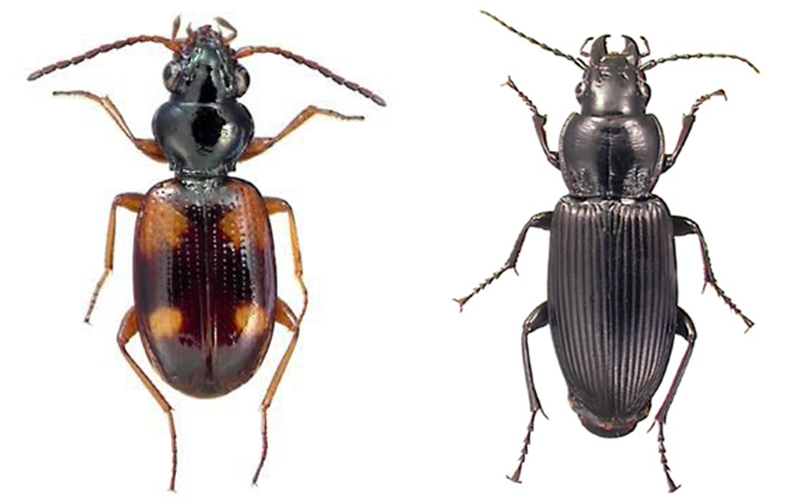
(Source: Species Bank, Canadian Biodiversity Information Facility from ‘Ground Beetles of Canada’, Goulet and Bousquet, www.cbif.gc.ca
Biological Control
Two generalist carabid ground beetle species may attack pea leaf weevil in Saskatchewan. Bembidion quadrimaculatum (L.) is a very small (approximately 3 mm) beetle that eats small insect eggs at or near the soil surface. This species was found to the be largest consumer of pea leaf weevil eggs during a lab study (Figure 9). Pterostichus melanarius (Illiger) is a larger (greater than 12 mm) beetle that will eat smaller beetles. Peak activity of this beetle coincides with peak emergence of new generation weevils, which may help reduce the overwintering population (Figure 10). However, field studies are needed in the Prairies to fully understand which natural enemies are having the most impact on the pea leaf weevil.
Cultural Control
Seeding Date: Field observations have shown that damage from pea leaf weevil is worse in the first host crop fields to emerge. Research in Idaho showed that peas seeded at least nine days later had less foliar feeding damage than early-seeded peas because the later-seeded peas emerged after the peak colonization period of the overwintered adult weevils. However, delayed seeding is not always practical, as many growers seed peas and faba beans first due to their tolerance of cooler soils and spring frost, as well as for logistical reasons at harvest (ex. peas mature earlier, so harvest can be completed while other crops are still maturing). Earlier seeded crops, in general, have been found to yield higher compared to later seeded crops, so there is also a risk of losing yield by delaying seeding to mitigate pea leaf weevil damage. Seeding earlier can potentially help get the plants more established in order to withstand more feeding injury, but because the earlier crops will be colonized first, a seed treatment with insecticide should be
considered if pea leaf weevil is a concern in the area.
Reduced Tillage Systems: Additional work in Idaho showed that pea leaf weevil adults were more attracted to the bare soil in
conventionally-tilled plots which led to more foliar damage by adults, as well as more root damage by larvae, compared to no-till plots.
Cereal stubble in no-till plots also hid the emerging pea plants, making it harder for the overwintered adults to identify their host plants. There were also higher numbers of new generation adults that emerged in the conventional plots, as well as higher survivability from egg to adult by the weevils. The cooler soils in the no-till plots led to delayed emergence of the peas and root nodule development was also slower which may make it harder for newly hatched larvae to find host roots.
Reduced tillage systems also better support beneficial insects such as ground beetles that prey on the pea leaf weevil. However, pea leaf weevil is still an issue in Alberta and Saskatchewan where reduced tillage has long been practiced.
Crop Rotation: Since adult pea leaf weevils are strong fliers and can travel fair distances (a few kilometres), the effectiveness of crop rotation is limited. Peas or faba beans planted following a perennial legume or in close proximity to perennial legumes will likely have severe feeding damage where pea leaf weevil is well established. Rotating to a non-host crop is also an option.
Trap Cropping: Seeding the outside of the field 10 days earlier than the inside of the field using the same cultivar can draw the adults into the early area, which can then be sprayed if necessary before the weevils move into the later-seeded area of the field. Additional time and logistics are necessary considerations for trap cropping.
Intercropping: Intercropping pulse crops with cereal crops makes it more difficult for adult weevils to find suitable host plants which
significantly reduces weevil numbers. The increased biodiversity also increases beneficial insect populations in general.
Nitrogen Application: High levels of soil available or applied nitrogen cause reduced nodulation in pulses, thereby making the plants less suitable for larval development and the crop less prone to yield loss. While fertilizing pulse crops with nitrogen defeats the purpose of planting legumes for conventional growers, organic growers could apply manure to help mitigate pea leaf weevil damage.
Summary
- Foliar feeding on legume crops is generally considered non-economical, with the exception of small seedling perennial forages such as alfalfa, which may have to be monitored more closely.
- Scout crops after emergence until the sixth node stage.
- A seed treatment is the best chemical option for pea leaf weevil protection. If in an area that saw high pea leaf weevil populations the previous year, use a seed treatment in peas and faba beans the next year. Use the survey map as a guideline for risk.
- Foliar insecticides are generally ineffective in protecting yield and should only be attempted as a rescue treatment. In peas, only apply a foliar insecticide if 30 per cent of the plants have notches on the clam leaves.
- Young seedlings are most susceptible to damage. Ensure a quick crop establishment to help mitigate losses.
- Use high quality seed with good germination and minimal seed-borne disease. Calculate proper seeding rates using the thousand kernel seed weight. Handle seed carefully to avoid cracking the seed coat. Use a seed treatment with both fungicide and insecticide components, properly inoculate with the correct Rhizobium inoculant, and check seed treatment and inoculant compatibility. Fertilize accordingly.
- Avoid seeding into excessively cold and wet soils, and do not plant too deep.
